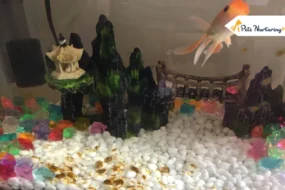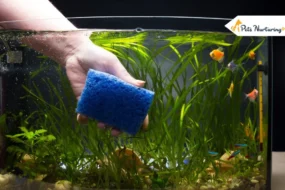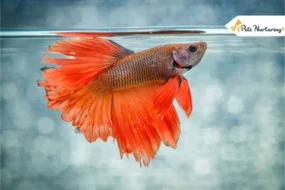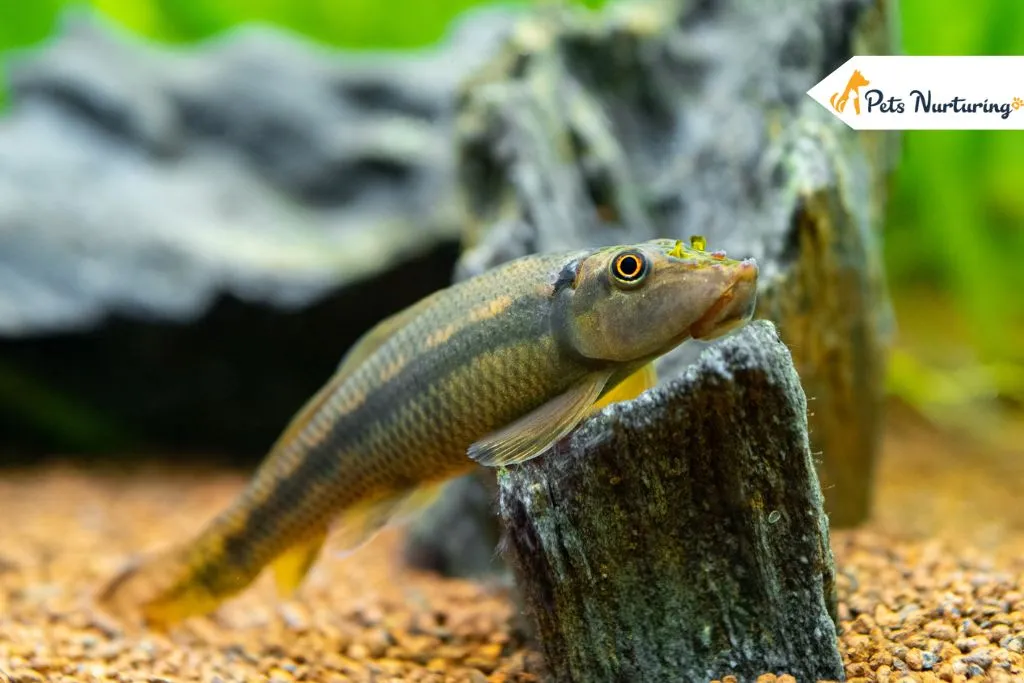
Attention all aquarium enthusiasts! Are you tired of constantly battling algae growth in your tank? Look no further because we have compiled a list of the best algae eaters for your aquarium. Not only will these aquatic creatures keep your tank clean and clear, but they also make great additions to any underwater ecosystem. Let’s see algae eater fish.
From algae eater fish to snails, we have covered you with our top picks for keeping that pesky green stuff at bay. So sit back, relax, and prepare to learn about some amazing algae-eating helpers for your beloved aquarium!
- What Are the Benefits of Having Algae Eaters In Your Aquarium?
- Top Algae Eaters
- 1. Cherry Shrimp
- 2. Florida Flagfish
- 3. Mollies
- 4. Rabbit Snail
- 5. Golden Nugget Pleco
- 6. Whiptail Catfish
- 7. Common Pleco
- 8. Malaysian Trumpet Snail
- 9. Spixi Snail
- 10. Mystery Snail
- 11. Clown Pleco
- 12. Amano Shrimp
- 13. Ghost Shrimp
- 14. Nerite Snail
- 15. Bamboo Shrimp
- 16. Rubber Lip Pleco
- 17. Otocinclus
- 18. Bristlenose Pleco
- 19. Hillstream Loach
- 20. Siamese Algae Eater
What Are the Benefits of Having Algae Eaters In Your Aquarium?
Before we tell you about the best algae eaters, we will tell you why you should get algae eaters in your aquarium or the benefits of having algae eater fish for the aquarium.
Here are the benefits of having algae eaters in your aquarium:
1. Algae Control
The primary reason for having algae eaters is that it eats all the algae from the aquarium. They help control and reduce algae growth in your aquarium, preventing it from overtaking the tank and harming other plants and fish.
2. Improved Water Quality
Algae eater fish maintain good water quality by consuming excess nutrients in the water, which helps prevent algae blooms and keeps the water clean and clear.
3. Aesthetic Appeal
By controlling algae growth, algae eaters help keep your aquarium visually appealing. They prevent the formation of unsightly algae films, green water, and algae-covered surfaces, ensuring a more attractive and pleasing environment.
4. Alleviates Maintenance Efforts
Having algae-eaten fish in your aquarium reduces the need for frequent manual cleaning and algae removal. They actively consume algae, minimizing the need for excessive scrubbing and maintenance.
5. Compatibility With Other Fish
Many algae eaters are peaceful and compatible with a wide range of fish species. Adding them to your aquarium can create a harmonious community and reduce aggression among fish.
6. Natural and Eco-Friendly Solution
Algae eaters provide a natural and eco-friendly solution to algae control. Instead of relying solely on chemical treatments, having algae eaters allows for a more sustainable approach to maintaining a healthy aquarium ecosystem.
7. Educational and Entertaining
Algae-eating fish can be fascinating to observe, especially during their feeding behavior. They add an educational and entertaining aspect to your aquarium, making it more engaging and enjoyable for children and adults.
By considering these benefits, you can make an informed decision when selecting algae eaters for your aquarium, leading to a healthier and more visually appealing aquatic environment. You can also get algae eater fish for sale for your aquarium.
Top Algae Eaters
1. Cherry Shrimp
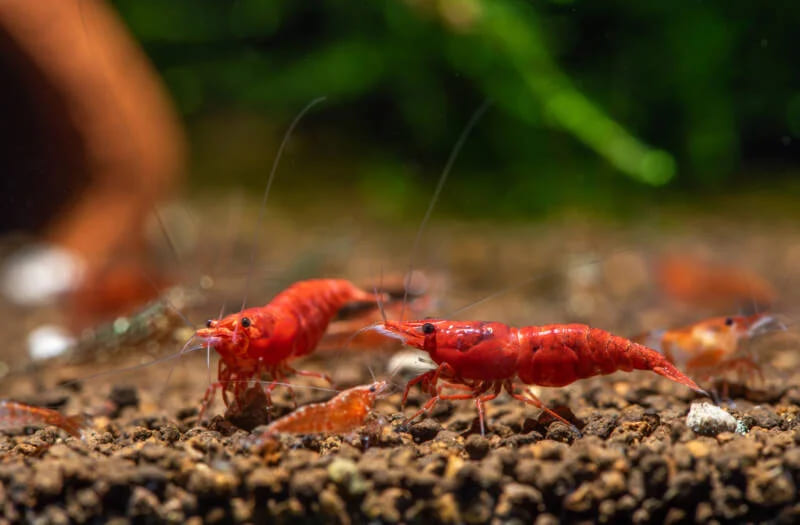
| Algae they eat | Soft green algae, biofilm, some hair algae, thread algae |
| Size of cherry shrimp | 1 to 1 ¼ inches |
These Algae eater fishes are of bright red colors. They are very energetic omnivores that will easily eat the algae in the tank.
They are generally peaceful and, thus, avoid keeping them with fish that are aggressive in nature.
They do their best when in a group of at least 10.
If you are planning to get cherry shrimp, you should give special attention to the tank size. It should be big enough to accommodate all the cherry shrimps.
2. Florida Flagfish
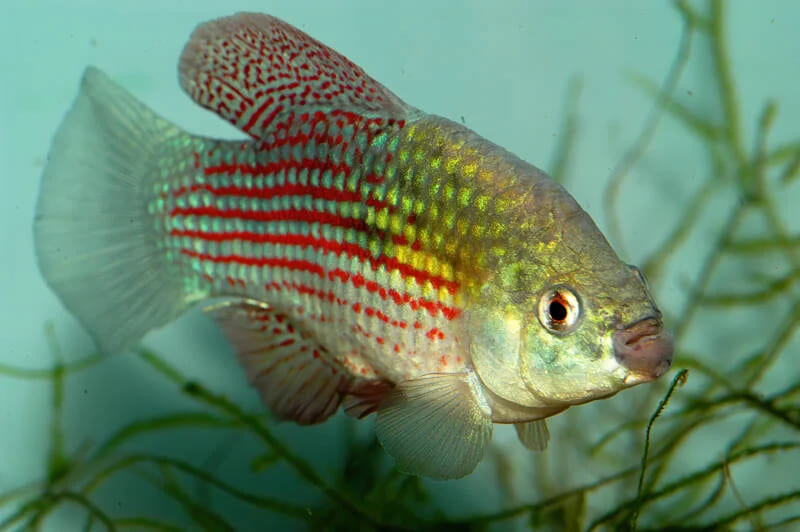
| Algae they eat | Hair algae, and black beard algae |
| Size of Florida flagfish | 1 to 1 ¼ inches |
Florida flagfish, also known as American flagfish, are considered enthusiastic eaters. They are best when it comes to keeping algae blooms under control. Click here to see these small aquarium fish.
These fish have amazing patterns on their scales that have a somewhat similar appearance to the American flag. They are semi-aggressive towards the other species.
If you are planning to keep this algae eater fish, try to keep them in a group of 5.
Taking care of these fish is easy. Looking at all these things, these fish can be an excellent choice for eating algae.
3. Mollies
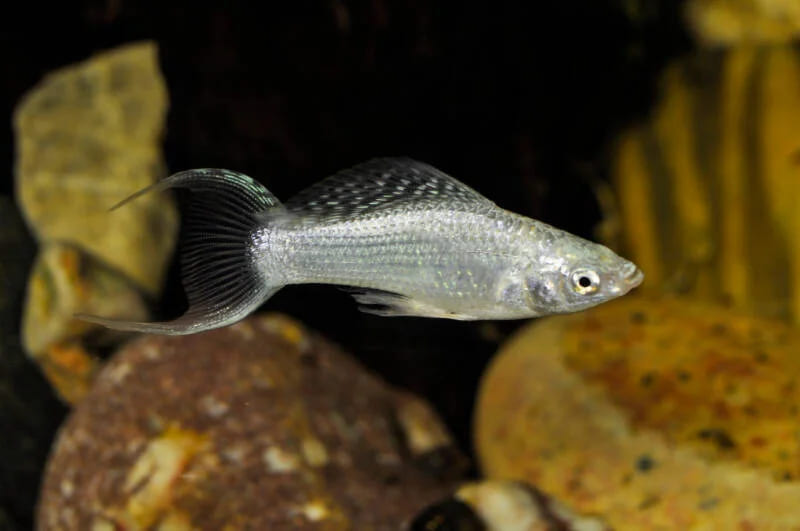
| Algae they eat | Fuzz algae, hair algae, Oedogonium algae |
| Size of mollies | 3 ½ to 6 inches |
Finding a type of live-bearing fish that appeals to you and fits your tank will be simply because they have been bred in so many different color varieties.
These fish naturally consume diverse kinds of algae, but it does not provide all of their nutritional needs. They can effectively combat hair algae in a home aquarium, but you will need to supplement their diet to keep them healthy.
Try to keep mollies algae eater fish at least in the group of four.
4. Rabbit Snail
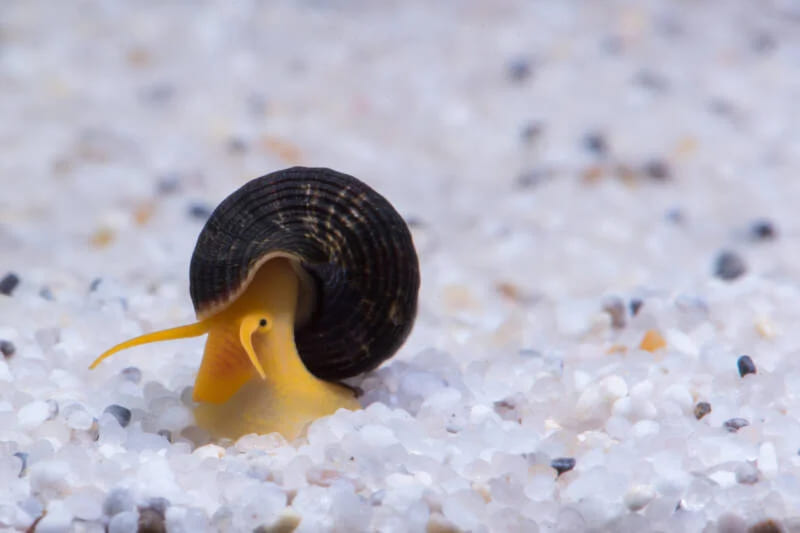
| Algae they eat | Green dust algae, free-floating algae |
| Size of Rabbit snail | 3 to 5 inches |
They have long, colorful shells, which also make the tank very attractive when they are inside it. They stay active in day and night as well. They love eating algae, leftover fish food, and decaying plant matter.
5. Golden Nugget Pleco
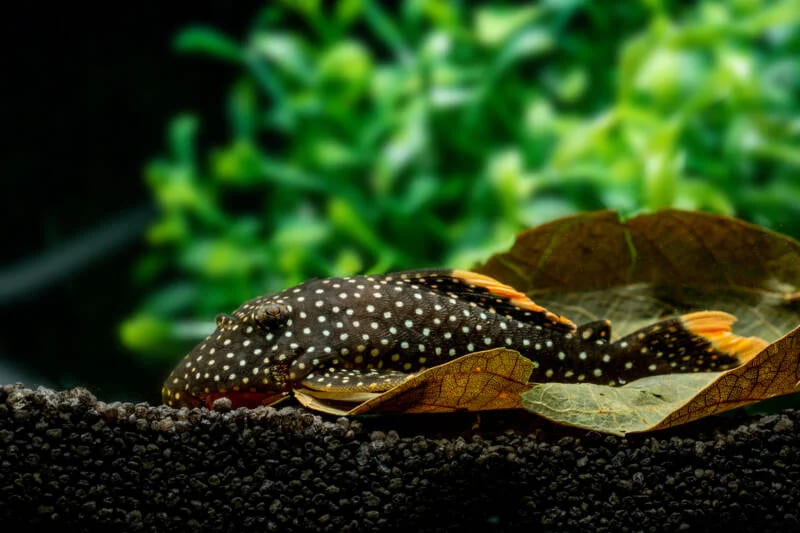
| Algae they eat | Green algae, brown algae |
| Size of Golden Nugget Pleco | Around 10 inches |
The golden nugget pleco’s vivid yellow patches stand out compared to most plecos, which mix in with their surroundings. They also have dazzling gold fin tips on their dorsal and caudal fins.
They are peaceful in nature. However, make sure to buy a large tank for them as they are of big size.
6. Whiptail Catfish
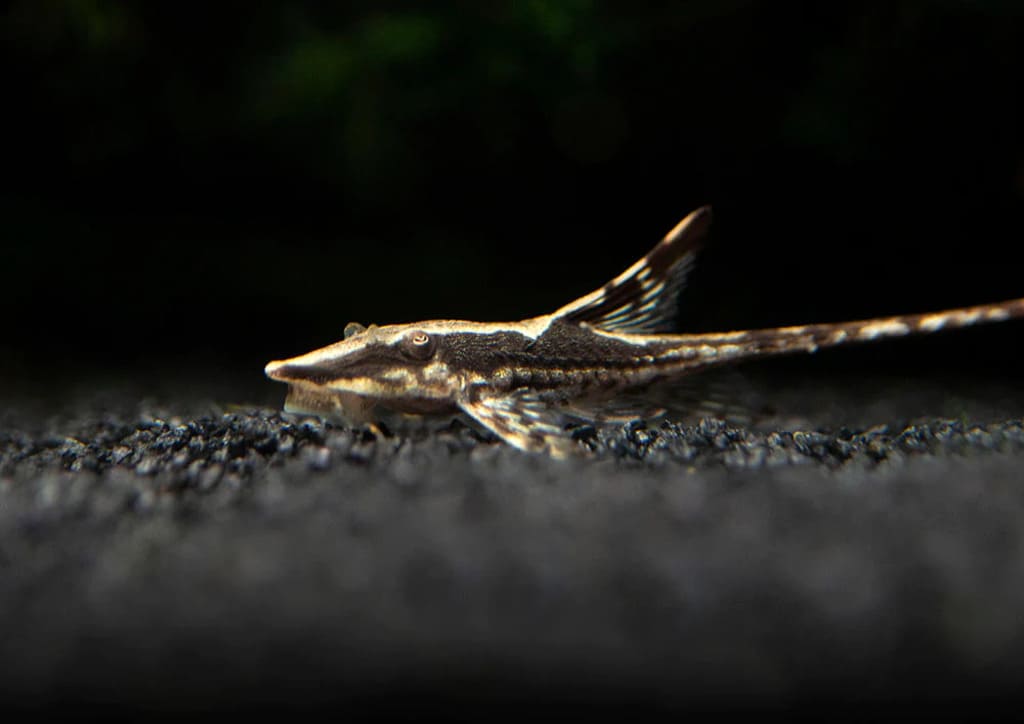
| Algae they eat | Green algae |
| Size of Whiptail catfish | Around 4 inches |
The whiptail catfish are peaceful in nature. They may not be involved in the heavy consumption of algae, but they will consume it a lot when it comes to green algae. As this algae eater fish is large-sized, they will need a big tank of around 75 gallons. Do remember that the water should be cool and will need well-oxygenated water.
7. Common Pleco
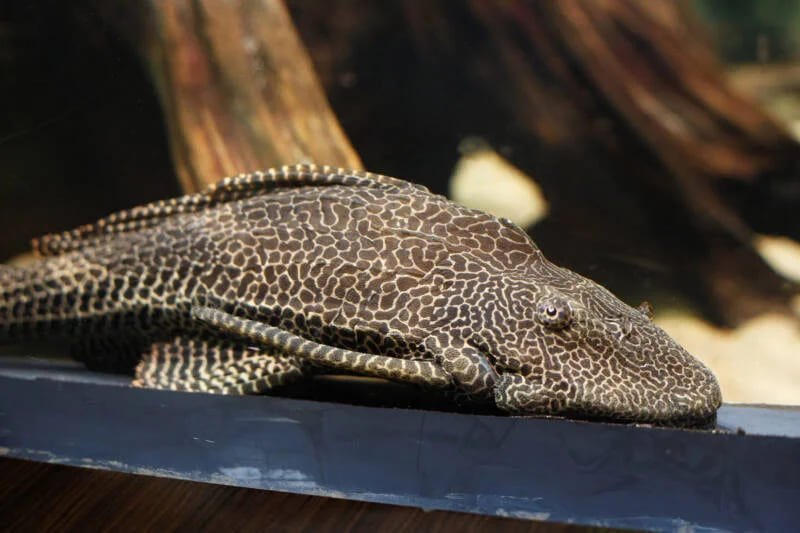
| Alga eaten by them | Green algae, String algae, brown algae |
| Size of Common Pleco | Up to 15 inches |
Common Pleco, the algae eater fish, is a part of the Loricariidae family. However, they are perfect for consuming the algae.
When it comes to buying common pleco, you need to consider some important factors. First is their consumption changes because when they are young, they will consume algae, but when they grow, they tend to eat more meaty foods and may lose interest in eating algae.
8. Malaysian Trumpet Snail
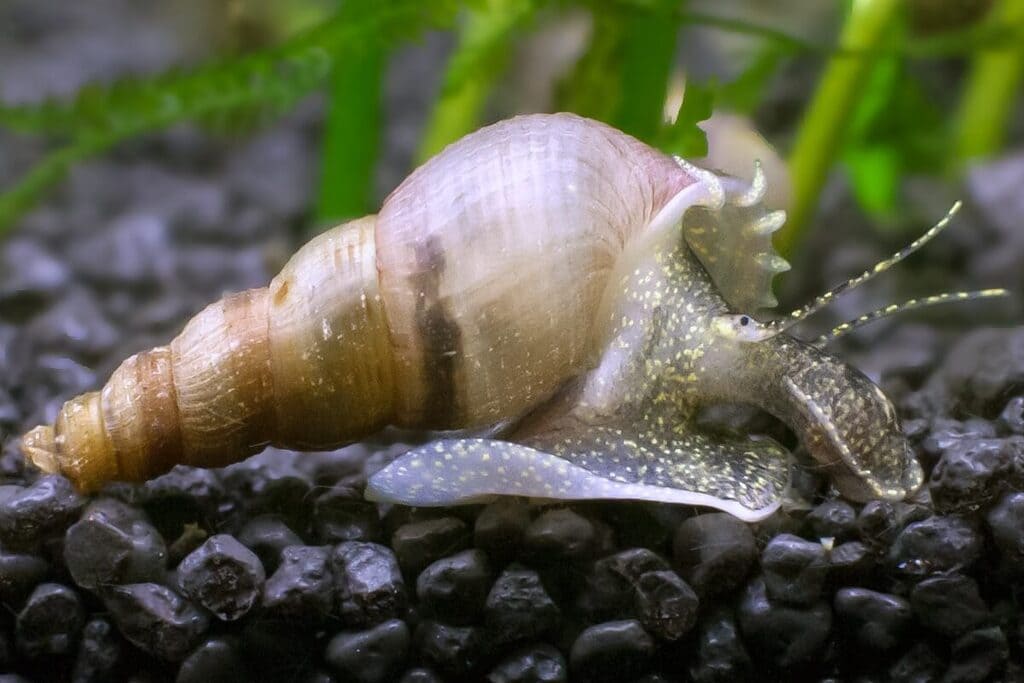
| Algae they eat | Free-floating algae, hair algae, and green spot algae |
| Size of Malaysian trumpet snail | 0.8 to 1.5 inches |
The Malaysian trumpet snail can be a great addition to your tank.
Taking care of this algae-eating fish is very easy. These creatures go under the soil in the daytime, and thus, they will need a sandy substrate.
9. Spixi Snail
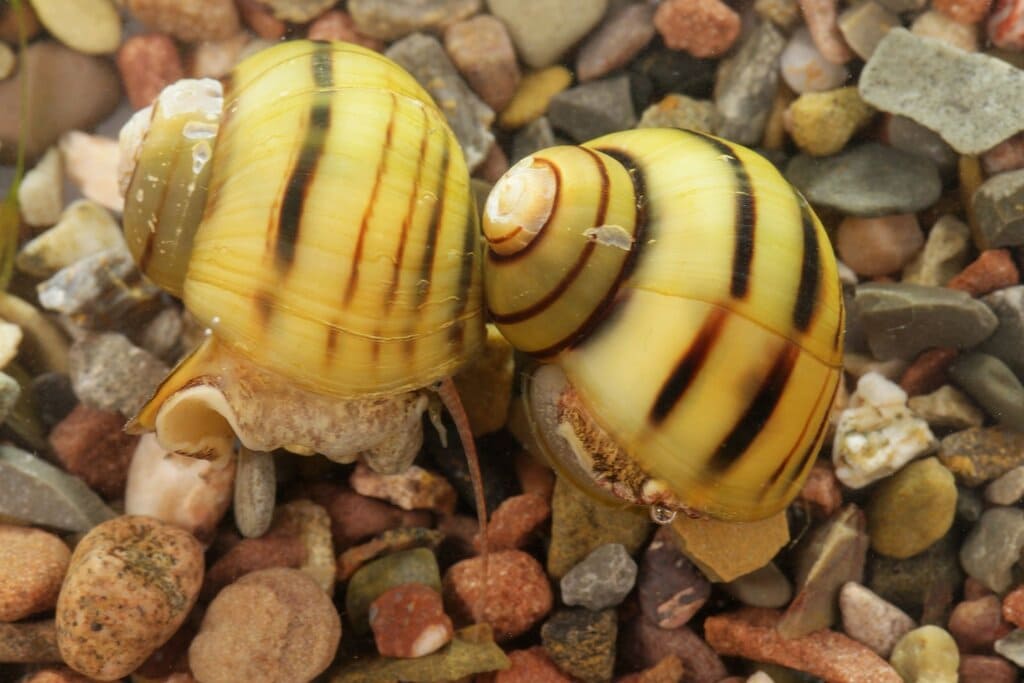
| Algae they eat | Aquarium algae, green hydra, and free-floating algae |
| Size of a Spixi snail | Around 1 inch |
These creatures are very happy when it comes to eating algae.
They may not be the best algae-eaters, but they can eat hydra, which may have a lot of algae attached to them. Thus, it can be a good choice for your tank.
Do note that these snails are semi-aggressive in nature. Also, they can munch on the aquarium plants, thus pairing them with the leafed varieties.
10. Mystery Snail
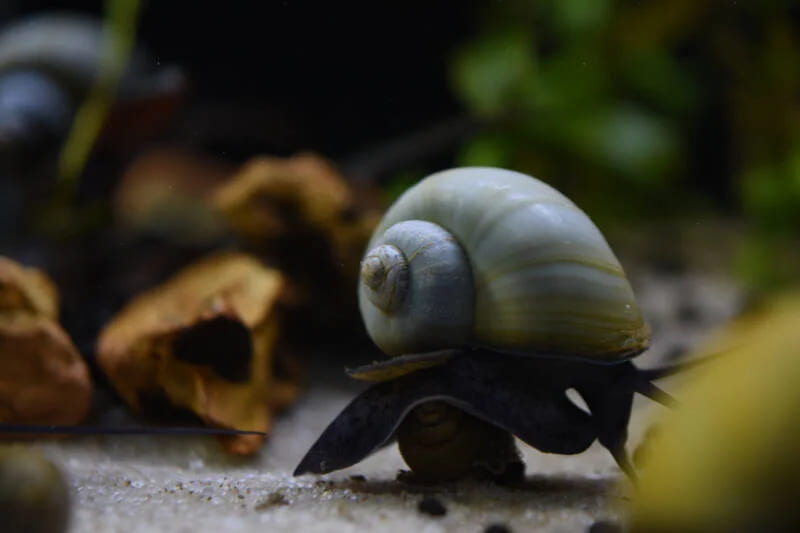
| Algae they eat | Hair algae, blue-green algae, and free-floating algae |
| Size of a Mystery snail | 2 inches |
Mystery snails, also known as apple snails, are popular members of the home aquarium cleanup crews. These creatures will eat algae, substrate, and also plants.
The mystery snails have very interesting behaviors, like floating on the surface. They come in very pretty colors, making them an amazing addition to the tank.
11. Clown Pleco

| Algae they eat | Green algae, brown algae |
| Size of Clown pleco | 3.5 inches |
The clown pleco will need a mature tank that has established algae growth.
The clown pleco will eat heavily on the driftwood and also consume algae. They will need regular feedings of vegetables and meaty treats. Here you can see how to take care of flower shrimps.
These fish are peaceful in nature and can be a good addition to your tank.
12. Amano Shrimp
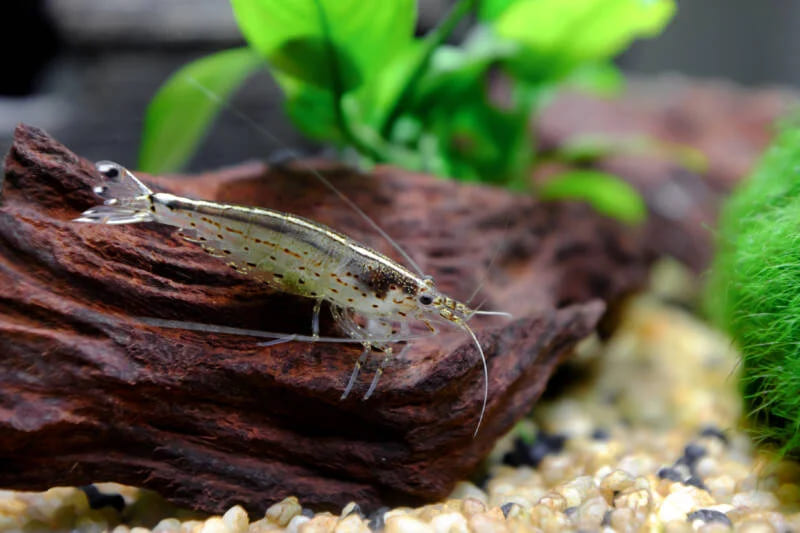
| Algae they eat | Black beard algae, hair algae, rhizoclonium algae, green algae, brown algae, green dust algae, fuzz algae, Oedogonium algae, free-floating algae |
| Size of Amano shrimp | 2 inches |
These small creatures are amazing algae cleaners for many aquarium surfaces.
They are small in size, which can also be a benefit and disadvantage. The benefit is that they are perfect for small tasks. Also, they have a very low bioload.
The disadvantage is that their small size makes them vulnerable to predation from shrimp-loving species.
13. Ghost Shrimp
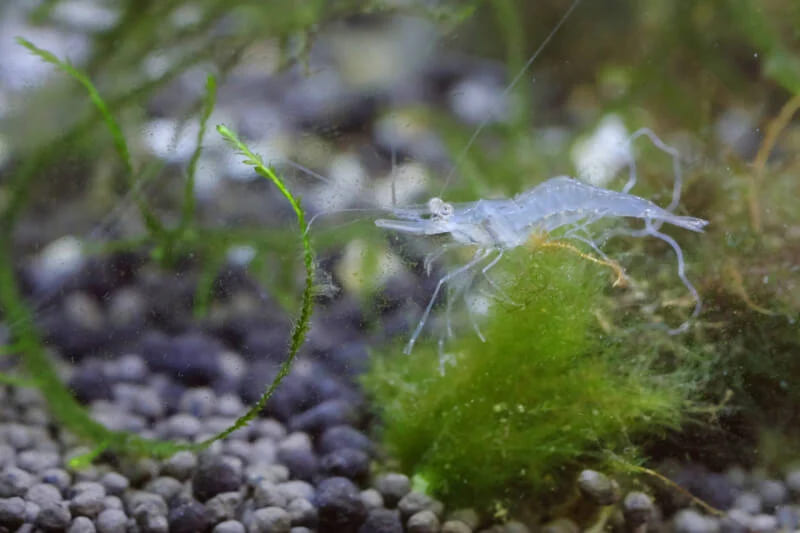
| Algae they eat | Brown algae and hair algae |
| Size of Ghost shrimp | 1.5 inches |
Ghost shrimp is an energetic and transparent species having all their organs visible.
Remember that they feed from the bottom; thus, they may not eat the algae attached to the glass but will easily eat all the algae at the bottom of the tank.
They won’t damage your plants as they prefer dead or decaying foods rather than plants.
14. Nerite Snail
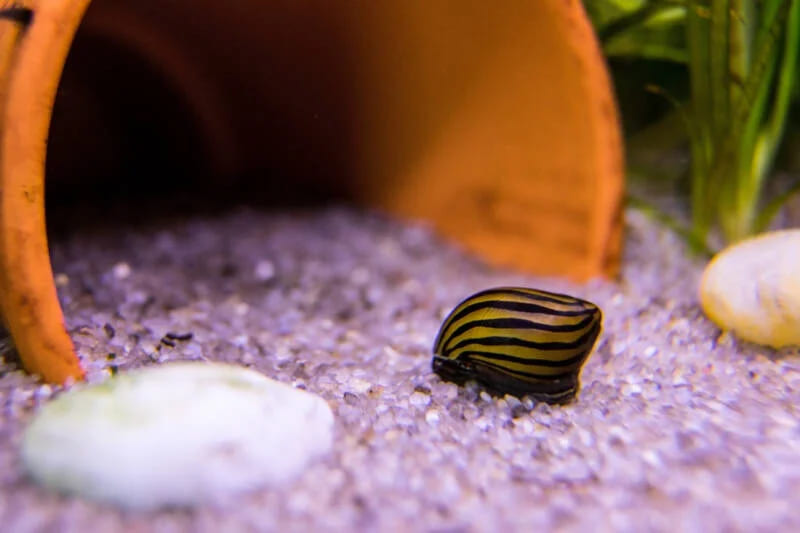
| Algae they eat | Green dust algae, green spot algae, hair algae, green algae, free-floating algae |
| Size of Nerite snail | Around 1 inch |
Nerite snails have beautiful patterns on their shells. They can live in freshwater as well as saltwater. If you want to know how long algae eater fish live, refer to our blog’s FAQs section. The best thing about the Nerite snails is that they eat almost all types of algae.
The limitation is that they are prolific egg layers. The eggs will not hatch in the freshwater tank; they will be everywhere.
15. Bamboo Shrimp
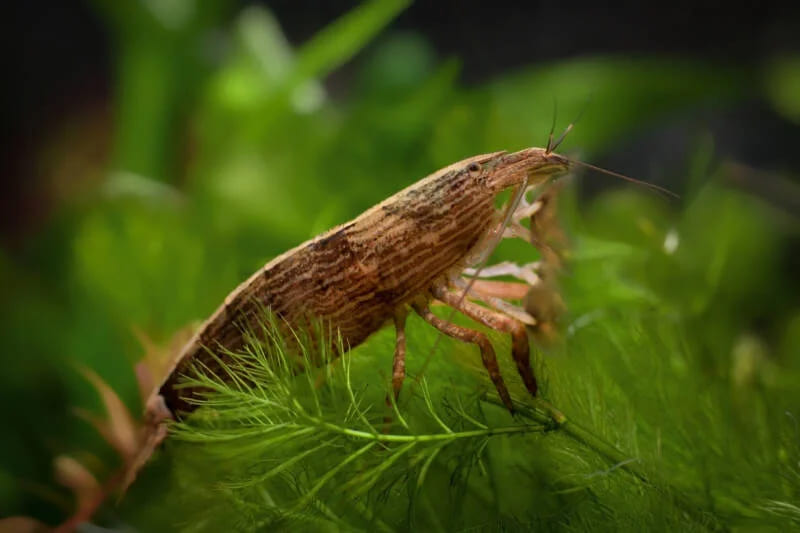
| Algae they eat | Free-floating algae |
| Size of Bamboo shrimp | 3 inches |
Filter-feeding bamboo shrimp are known. They extract microalgae and microorganisms straight from the water column using their distinctive, fan-shaped appendages.
They are ideal for managing free-floating algae but won’t eat algae attached to your aquarium’s surfaces.
16. Rubber Lip Pleco
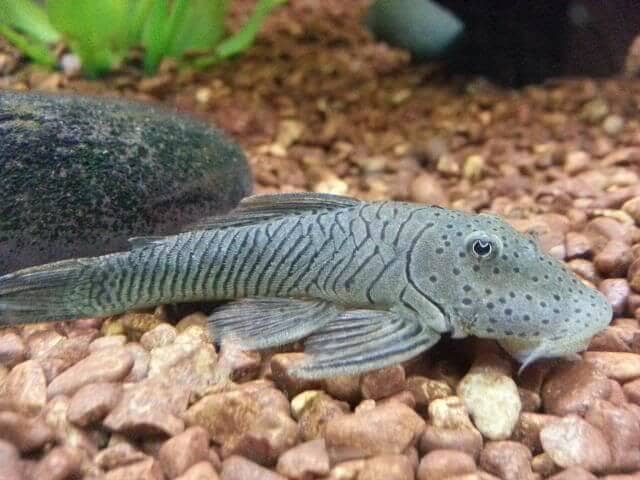
| Algae they eat | Green algae, brown algae, hair algae, black beard algae |
| Size of Rubber lip pleco | 7 inches |
Filter-feeding bamboo shrimp are known. They extract microalgae and microorganisms straight from the water column using their distinctive, fan-shaped appendages.
They are ideal for managing free-floating algae but won’t eat algae attached to your aquarium’s surfaces.
17. Otocinclus

| Algae they eat | Brown algae, green dust algae, green algae, fuzz algae |
| Size of Otocinclus | 2 inches |
It is calm-tempered, tiny, and easily accessible in most neighborhood fish stores. It has long been a favored aquarium fish for species that consume algae.
They will stay active in the daytime. However, do note that the cycled tank with high oxygen levels will not be able to stay in the high levels of waste buildup.
Try to keep these fish in the group of 4 to 6.
18. Bristlenose Pleco
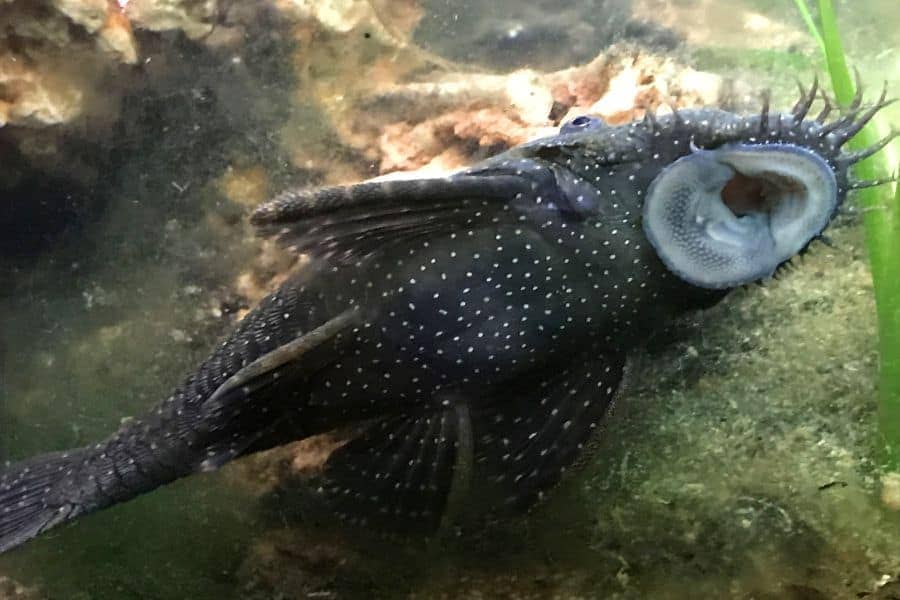
| Algae they eat | Green algae, brown algae, fuzz algae, green dust algae |
| Size of Bristlenose pleco | 4 to 5 inches |
The bristle nose is an herbivore. They will eat algae and biofilm in large amounts and are best at cleaning aquarium glass and other tank surfaces.
The younger bristle nose specimens may be more enthusiastic algae cleaners than the older ones.
They will need vegetables and meat if there is less availability of the algae.
Make sure to choose the right species of the mystery snail. Many species have the same name, among which some are pests, and their import is restricted.
The mystery snail will eat algae growing on the tank glass, substrate, and even plants.
19. Hillstream Loach
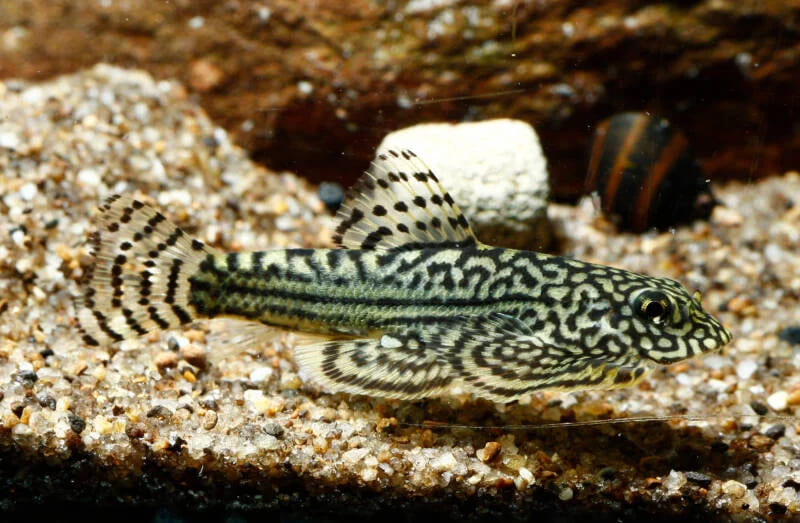
| Algae they eat | Brown algae |
| Size of Hillstream loach | Around 2 inches |
This creature hugs the substrate in fast-moving and cool water streams. They will need these water conditions in captivity and may not stay in the tropical tank.
These fish need a larger tank, so make sure the tank is big enough to fit the hillstream loach.
Try to keep them in the group of 3 to 4. They largely eat brown algae but won’t be interested in black beard and green spot algae.
20. Siamese Algae Eater
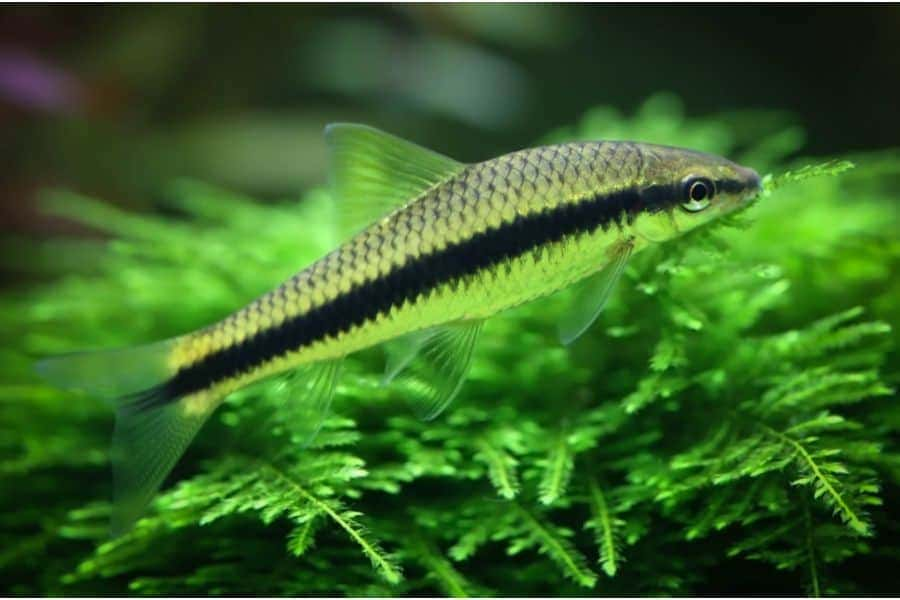
| Algae they eat | String algae, red algae, hair algae, fuzz algae |
| Size of Siamese algae eater | Around 6 inches |
It is advised to keep them in a group of a minimum of 5.
The fish will require hot water. If you keep them in the outdoor pond, you must bring them indoors for the colder season.
Make sure you are getting a genuine Siamese algae eater. There are several same breeds, like Chinese algae eater or Siamese flying fox.

FAQs
Yes, algae eaters do keep the tank clean.
The fish algae are not considered harmful. However, algal blooms like blue-green algae can be dangerous to humans.
Yes, almost all the algae eater fish freshwater snails consume algae.
The answer to the question of what algae eater fish eat is –algae and phytoplankton.
Dirty water and the absence of oxygen levels may kill the algae eaters.
Final Words
At last, we would say that algae eater fish can be a great addition to your tank! They can eat all the algae in the tank and clean it up. Also, some algae eaters are so colorful that they increase the tank’s attractiveness.
For additional insights:








